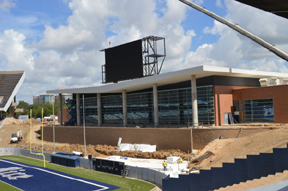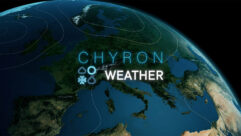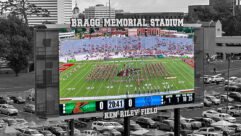
SVC Podcast – Show Notes – Show 157-2
In this edition of the SVC Podcast, SVC Contributing Editor Bennett Liles wraps up his interview with Dan Fjeldheim of Daktronics on the new 29ft. by 49ft. LED video display board being installed at the renovated football stadium at Rice University in Houston, Texas. Dan takes us behind the scenes and discusses the issues of heat dissipation and the LED video display board assembly technique. He also explains the specifications on LED video displays and what they mean to product performance.
For Part 1
Links of interest:
- Daktronics, a leading manufacturer of outdoor LED video displays
- The Daktronics video gallery
- Daktronics LED video displays by application
Download Podcast Here:
https://s3.amazonaws.com/nb-svc/public/public/157-2_Daktronics_Rice_U.mp3
From Sound & Video Contractor Magazine, this is the SVC Podcast with Dan Fjeldheim of Daktronics. Show notes and equipment links for the podcast are on the web site of Sound & Video Contractor Magazine at svconline.com.
In today’s sports stadiums the displays keep getting bigger and more technologically advanced. That’s what’s happening with the Rice University football stadium renovation. A huge new Daktronics LED video display has taken shape and Dan Fjeldheim from Daktronics is back to wrap up his story of how it got there and how it all works. That’s up next on the SVC Podcast.
Dan, thanks for getting back with us for Part 2 on the SVC Podcast from Daktronics and we were talking about the Rice University football stadium renovation, a huge project, and the central focus of that is the massive new LED scoreboard and video display. As we talked about in Part 1, there were a lot of things going on at the same time. When did you get the go-ahead to begin construction on the board? You had to wait for some other things to happen first.
As I mentioned earlier we were kind of one of the later trades in the overall project to get going, so we weren’t really given a contract until about February of this year. And throughout that time, between February and now when the installation has started, we’ve got some engineering and some design work to work through. Obviously we have to manufacture the boards, both the LED video display and the audio façade in the computer. So it’s been a process that generally takes about 90-120 days and we’re kind of right in that window right now of getting everything installed. [Timestamp: 1:47]
And this display structure sits on top of a building so what is the weight consideration on this thing? You had to have the building made to support it so how much does the entire display structure weigh?
It really depends on the size. A board like this at Rice weighs about 30,000-35,000 pounds. So we gave them those estimates early on in the process so the engineer that designed this structure that this board is going to mount to could take that into account and make sure he had enough structural steel there to support what we were going to put up. [Timestamp: 2:19]
And one of the prime considerations on this is heat dissipation. You’ve got a lot of LEDs burning in there so how is heat handled within the display? Is it a natural convection current from bottom to top or do you have fans in there? Does it generate much heat or trap heat from the sun?
Each one of the modules – and when I say module I mean roughly a foot-by-foot section of the LED – has a fan on it. That fan will blow air on the electronics so they don’t overheat. Along with that the top and the bottom of the display are open so that allows for some free-flowing air to be able to blow through that cabinet to kind of trap any hot air that will be back there and let that flow through both the top and the bottom of the display. So there’s a couple of ways that we can get hot air out of there so the electronics don’t overheat. [Timestamp: 3:10]
And this isn’t a sort of experimental situation. You have put in similar LED video display boards for this type of application in other venues.
Correct. We have other displays around Houston. You can take for example the Houston Astros have a similar product that Rice has looked at and a similar concept of the fans on the modules. And then the Astros have an opening on the side of their display because they don’t have the audio system on the sides like Rice does. But as long as we have an opening top or bottom or on both sides we’re able to get some air flowing through there and combine that with the modules that have the fans on them to keep that air flowing through. That’s how we can keep those. Interesting to note that if you looked at a video display 8-10 years ago, if it was an outdoor application in a warmer climate such as Houston you would need to have air conditioning. We still have some older displays with older technology that have actual air conditioning units behind the boards to help keep it cool. But as the technology has advanced and we’ve been able to go with fans on the modules and get the air flowing through the sides and the top and bottom of the cabinet, we eliminated that need for the air conditioning. So that’s a nice feature that we don’t have to worry about any more. Obviously those air conditioning units suck a lot of power and are not the funnest to maintain so it’s been a nice advantage that we’ve gotten able to get away from the air conditioning. [Timestamp: 4:37]
Yes, technology marches on and a lot of this business on these displays is one-upmanship and who has the biggest display and the latest technology. When you install one of these do you put the whole thing together at Daktronics and then take it apart and transport it to the site or is it first assembled onsite?
The display itself will come in different sections and depending on the overall size of that display – like here we’re 29 feet tall by 49 foot wide – we’ll figure out what is the good fit for the amount of sections we can make. Our modules come in roughly foot-by-foot sections so we try and maximize the amount of sections so we don’t have to install as many as possible, but we also want to do a section that’s manageable and easy to put together, kind of like a puzzle. So for example at Rice it’s 20 sections and so each of those 20 sections is built in the factory and each of those sections is tested individually in order to make sure it’s operating properly, that the LEDs are the right colors and those type of things. And then when they get to the site, although they’ve already been tested in the factory, once we get everything put together then the overall display is tested to make sure each of those sections have the same consistency of brightness and colors and those type of things. So I guess to answer your question we do it in both places – both in the factory and onsite. [Timestamp: 6:00]
Okay. And of course you have to fasten all of the modules together and be able to replace any one of them. How is the wiring connected between the panels? Is it with connectors integral to the module or do you have wiring with external connections?
Well each module has a ribbon cable that goes between it. So you’ve got the signal flowing left to right, but you also have the signal flowing right to left. And the reason we do that is if for some reason we have a cable go bad or something would happen to one of the components, if you lose signal coming from one way at least you have it coming from the other way. Now our diagnostics will tell you that hey, there’s a problem with this module, A12, whatever it may be, however you may not see a visual outage on the display because we have that redundant signal path going back and forth. So basically we’ve got signal flowing both ways through the board to help eliminate any visual outages that you might see. [Timestamp: 6:57]
And when you are considering the specs on a large outdoor LED video display board you have certain things to specify or to look for as a feature. One of the main ones I figure is pixel pitch… along with matrix area. Are those the two main ones or is there something else that you look for when you’re going at these things?
Yeah. For example on Rice our consultant specified a certain product and said this is the type of resolution we want. So if we know that the display is going to be 29 by 49 and they want their lines of resolution to be on 13 mm spacing, we know what that roughly gives as far as a pixel count goes. So pixel count and the actual pixel pitch are really the two main factors based on the size of the display on how much resolution you’re going to have. [Timestamp: 7:46]
Well, it’s a huge project with everything that’s going on for the Rice University Stadium renovation and the crowd will, I’m sure, be delighted when football games start up again. What’s Daktronics got coming up on other big video display projects?
As far as some larger projects going on at Daktronics right now there’s quite a few NFL stadiums that we are in the process of finishing up. The Minnesota Vikings is a new stadium that we did that is just finishing up here. That was a brand new stadium, a billion dollar stadium that they built in Minneapolis. The Atlanta Falcons is one that we’re just getting started on. When that one is going to be finished up that will be the largest LED display in the world. That’s kind of a cool application where it’s, I guess, envision is as kind of a circular halo that is going to hang in the middle of their new stadium. So that will be an exciting project. That stadium doesn’t open until 2017, but as you can imagine a project with the scope of that and how big that’s going to be, that will be a longer installation than normal. We’ve also got some current installations going on for this fall at the Miami Dolphins and the Tampa Bay Buccaneers. We’re kind of proud of the Buccaneers in the sense that they were one of the first NFL teams to purchase an LED video display from Daktronics and they bought it in 1997. So when you think about Daktronics’ reputation of product quality and longevity, they’ve had that display in their stadium 18-19 years before they actually replaced it. So that was a good testament to what we were doing back in the late 90’s when this technology first hit the market. We were able to keep that thing functional for almost 20 years and the Bucs will be getting the new 13HD product that we talked about as part of their new stadium as well. And a couple other ones we’ve done recently in major league baseball, the St. Louis Cardinals also put a new 13HD product in as well. So a lot of good things going on at Daktronics in larger sports stadiums and we’re very excited about the opportunity to showcase a lot of these this fall. [Timestamp: 9:56]
I’m only a few miles down the road from the new Falcons stadium so I’ll check that one out when you have it completed. Dan Fjeldheim from Daktronics and the new LED video display at Rice University Stadium. Thanks for taking us behind the scenes on this project, Dan.
Hey, Bennett, thanks for the opportunity to visit with you. Appreciate it.
Thanks for joining us for the SVC Podcast with Dan Fjeldheim. Show notes and equipment links are on the website of Sound & Video Contractor Magazine at svconline.com. Be back with us next week for the next SVC Podcast.










